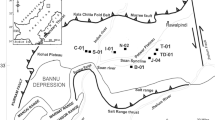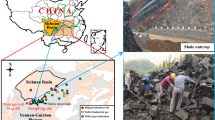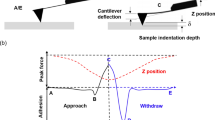Abstract
Shale samples from designated units of the Imo, Nsukka, Mamu, Enugu and Nkporo Formations of the Anambra Basin were subjected to X-ray diffraction and geotechnical index tests to determine the potential of the Formations to either create hydrocarbon migration pathways or to form seals for hydrocarbon entrapment. The X-ray diffraction results indicate that the shales are made up of silicate minerals with carbonates and sulphates. Results of the geotechnical index tests showed that the plasticity index (PI) for the Enugu shale ranges from 16 to 24 (average of 20) while the toughness index (TI) ranges from 0.4 to 0.8 (average of 0.7). The PI for the shales of Imo and Nsukka Formations ranges from 62 to 72 and 34–59 with averages of 67 and 46 respectively while their TIs range from 0.8 to 1.7 and 1.5–2.2 with averages of 1.3 and 1.9, respectively. These properties dispose the Enugu shale to easy amenability to loss of cohesion, deforming in a brittle manner, when subjected to shearing stress with the ability to create joints and faults that are pathways of hydrocarbon migration. Conversely, the properties of the shales of the Imo and Nsukka Formations give them the capacity to absorb high shearing stress without loss of cohesion thereby deforming in a ductile manner, which prevents the leakage of fluids in fluid migration. Hence, Enugu shale has the highest potential of creating hydrocarbon pathways while the shales of the Imo and Nsukka Formations are better seal rocks than others.








Similar content being viewed by others
References
Agagu OK, Ekweozor CM (1982) Source rock characteristics of Senonian shales in the Anambra syncline. J Min Geol 19:132–140
Atkinson JH (1993) An introduction to the mechanics of soils and foundations: through critical state soil mechanics. McGraw-Hill Int, UK
Avbovbo AA, Ayoola O (1981) Petroleum prospects of southern Nigeria’s Anambra Basin. Oil Gas J 79:334–347
Bjerrum L (1954) Geotechnical properties of Norwegian marine clays. Geotechnique 4(TAI.G3):49–69
Bott MHP (1976) Mechanism of basin subsidence—an introductory review. Tectonophysics 36:1–4
Burke K (1972) Geological history of the Benue valley and adjacent areas. In: Proceedings of the conference on African geology. Department of Geology, Univ. of Ibadan, Ibadan, Nigeria, December 1970, pp 187–205
Burmister DM (1951) Identification and classification of soils. Symposium on Identification and Classification of Soils, special technical publication No. 113, American Society for Testing Materials (TA710.A5), pp 3–24
Chukwu-Ike JM (1977) A crustal and lineament in North Africa—discussion. Tectonophysics 40:375–380
Ekweozor CM (1982) Petroleum geochemistry application to petroleum exploration in Nigeria’s Lower Benue trough. J Min Geol 19:122–130
Ekine AS (1989) Empirical heat flow studies; geohistory analysis and hydrocarbon maturation studies in the Anambra Basin, Nigeria. PhD dissertation, University of Nigeria, Nsukka
Genik GJ (1993) Petroleum geology of cretaceous-tertiary basins Niger, chad and central African republic. AAPG Bull 77:1405–1434
Grant NK (1971) South Atlantic, Benue trough and Gulf of Guinea triple junction. GSA Bull 8:2295–2298
Hibbard MJ (2002) Mineralogy: a geologist’s point of view. McGraw-Hill companies Inc, New York
ICDD (1978) The international centre for diffraction data. ICDD Information display web. http://www.icdd.com/profile/overview.htm. Accessed 3rd Feb 2012
Ladipo KO (1987) A depositional framework for the Anambra Basin, Southeastern Nigeria. Bull Centres Rech Explor—Prod Elf—Aquitaine 11:166–167
Means RE, Parcher JV (1963) Physical properties of soils. Charles Merill books, Columbus
Murat RC (1972) Stratigraphy and paleogeography of the cretaceous and lower tertiary in Southern Nigeria. In: Dessauvagie TFJ, Whiteman AJ (eds) African geology. University of Ibadan Press, Ibadan, pp 251–276
Nagy RM, Chuma MA, Rogers JJW (1976) A crustal suture and lineament in North Africa. Tectonophysics 31:67–72
Njumbe E (1995) Seismic velocity modelling in the Anambra Basin, Southeastern Nigeria. M.Sc dissertation, University of Nigeria, Nsukka
Nwajide CS (2006) A guide for geological field trips to Anambra and related sedimentary basins in Southeastern Nigeria. A publication of the Petroleum Tech. Dev. Fund (PTDF) chair in Geology, Univ. of Nig. Nsukka. Great AP Express publishers Ltd, Nsukka
Obaje NG, Ulu OK, Petters SW (1999) Biostratigraphy and geochemical controls of the hydrocarbon prospects in the Benue Trough and the Anambra Basin, Nigeria. NAPE Bull 14:18–54
Obi GC (2000) Depositional model for the Campanian-Maastrichtian Anambra Basin, Southern Nigeria. PhD dissertation, University of Nigeria, Nsukka
Obiora SC, Umeji AC (2004) Petrographic evidence for regional burial metamorphism of the sedimentary rocks in the lower Benue rift. J Afr Earth Sc 38:269–277
Ofoegbu CO, Odigi MI, Ebeniro JO (1990) On the tectonic evolution of the Benue Trough. In: Ofoegbu CO (ed) The Benue Trough, structure and evolution. Friedr. Vieweg. and Sohn Verlagsgesellschaft mbH, Braunschweig, Germany, pp171–201
Ojoh K (1990) Cretaceous geodynamics evolution of the Southern part of the Benue Trough (Nigeria) in the equatorial domain of the South Atlantic: stratigraphy, basin analysis and paleogeography. Bull Centres Resh Explor—Prod EIF—Aquitaine 14:419–442
Okoro AU (1995) Petrology and depositional history of sandstone facies of the Nkporo formation in the Leru area of southeastern Nigeria. Nig J Min Geol 32:105–112
Olade MA (1975) Evolution of Nigeria’s Benue Trough (Aulacogen)—a tectonic model. Geol Mag 112:575–580
Onuoha KM (2006) A closer look at the petroleum potentials of the Anambra Basin: inputs from geophysics and geohistory. In: Okogbue CO (ed) Hydrocarbon potentials of the Anambra Basin: geology, geochemistry and geohistory perspectives. Great AP Express publishers Ltd, Nsukka, pp 47–82
Onuoha KM, Ekine AS (1990) Pitfalls in the reconstruction of thermal histories and evaluation of maturation stages of oil and gas bearing strata. Nig Ass Pet Explor Bull 5(1):88–102
Petters SW (1978) Mid-cretaceous paleoenvironments and biostratigraphy of the Benue Trough, Nigeria. Geol Soc Am Bull 89:151–154
Punmia BC, Ashok KJ, Arun KJ (2005) Soil mechanics and foundations. Laxmi Publications Ltd, Daryaganj
Reyment RA (1965) Aspects of the geology of Nigeria. Ibadan University Press, Ibadan
Shroff AV, Shah DL (2003) Soil mechanics and geotechnical engineering. Taylor and Francis, UK
Skempton AW (1944) Notes on the compressibility of clays. Quart J Geol Soc Lond 100(QE1.G345):119–135
Stroud MA (1974) The standard penetration test in insensitive clays and soft rock. In: Proceeding of the 1st European symposium on penetration testing, Stockholm, Sweden, vol 2, issue no 2, pp 367–375
Unified Soil Classification System (1952) In: Bell FG (ed) Engineering geology, 2nd edn. Butterworth-Heinemann (Elsevier Ltd), Jordan Hill, pp 201–210
Varghese PC (2005) Foundation engineering. Prentice-hall, Englewood
Velde B, El Moutaoukkil N, Iijima A (1988) Compositional homogeneity in low temperature chlorite. Contributions to mineralogy and petrology. In: Price GD, Ross NL (eds) The stability of minerals. Chapman and Hall Companies Inc, London, pp 329–346
Whiteman AJ (1982) Nigeria: its petroleum geology resources and potential. Graham and Totman, London
Acknowledgments
This paper is part of ongoing studies on the hydrocarbon potentials of the Anambra Basin. The authors are grateful to Mr. Ogundare of Engineering Materials Development Centre, Akure, Ondo state, Nigeria for his assistance in the mineralogical analysis of shale samples and to the staff of soil mechanics laboratory, Department of civil engineering, University of Nigeria, Nsukka for the geotechnical index properties analyses.
Author information
Authors and Affiliations
Corresponding author
Rights and permissions
About this article
Cite this article
Okogbue, C.O., Ugwoke, T.S. Inferring Hydrocarbon Migration and Sealing Potentials of Some Shales of the Anambra Basin (South-Eastern Nigeria) from Their Paragenesis and Geotechnical Index Properties. Geotech Geol Eng 30, 1249–1260 (2012). https://doi.org/10.1007/s10706-012-9538-x
Received:
Accepted:
Published:
Issue Date:
DOI: https://doi.org/10.1007/s10706-012-9538-x




